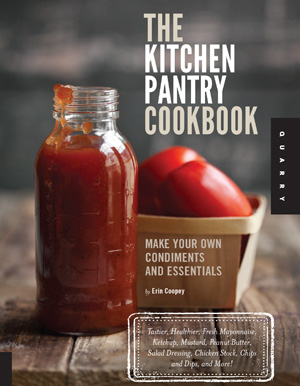
Ketchup vs. Catsup: What's the difference? Well, as far as I can tell there isn't actually a difference. I've read some accounts that suggest that catsup is spicier and ketchup is sweeter, but in researching recipes that hasn't really bared out. I think it's simply a case of semantics.
Historians suggest that ketchup is derived from an Asian condiment ke-chiap or kĕchap, made from pickled fish and spices. The sauce has morphed over the centuries. At its simplest, modern ketchup/catsup is a pickled fruit sauce. In my research, I've come across grape catsup, cucumber catsup and banana ketchup among others. Although tomatoes were brought over from the new world in the mid 1500's, they weren't fully embraced until the 1800's, which coincidentally is when they started to become the primary ingredient in ketchup/catsup.
So why do we mainly see more ketchup than catsup on store shelves these days? Remember back in the 1980's when there was discussion at the USDA of classifying ketchup as a vegetable for school lunches? Rumor has it that the proposal specified "ketchup" vs. catsup. This specification apparently turned the tide on naming as companies tried to cash in on the school lunch market. Companies wouldn't want to supply catsup if ketchup was requested on the purchase order.
Sweet and Spicy Ketchup
Makes about 2 cups
I just love this ketchup. The cloves and cinnamon intensify the sweetness of the tomatoes, while the mustard and cayenne give it just a teensy kick. It makes me want to grill up a burger and sit in the sunshine!
2 1/4 lb plum tomatoes
1 cup white vinegar
1/2 cup sugar
1/4 tsp cayenne pepper
1/4 tsp ground black pepper
1 tsp whole cloves
1 tsp mustard powder
1 tsp sea salt or kosher salt
1 tsp ground cinnamon
Bring a large pot of water to boil. Add the tomatoes and blanch until the skin breaks and the flesh becomes soft, about 5 to 10 minutes.
Drain the tomatoes and press through a fine-mesh food mill or sieve to remove the skin and seeds.
Pour sieved tomatoes into a medium-sized sauce pan. Add vinegar, sugar, cayenne, black pepper cloves, mustard powder and salt, stir to combine. Bring tomato mixture to a boil and then reduce heat to medium. Simmer, stirring occasionally, until the mixture has reduced to 1/4 the original amount and thickened, approximately 1 hour.
Use a slotted spoon to remove the whole cloves. Stir in cinnamon and refrigerate until cold. Store, covered in the refrigerator for up to 1 month.
Ketchup
Makes about 2 cups
You'll think you're eating a national brand - minus the high fructose corn syrup!
2 1/4 lb plum tomatoes
1 1/2 cups white vinegar
2 1/2 tsp sea salt or kosher salt
1 cup sugar
1 tsp onion powder
1/2 tsp mustard powder
1/4 tsp ground cinnamon
1/4 tsp ground cloves
1/4 tsp ground allspice
1/4 tsp ground black pepper
Bring a large pot of water to boil. Add the tomatoes and blanch until the skin breaks and the flesh becomes soft, about 5 to 10 minutes.
Drain the tomatoes and press through a fine-mesh food mill or sieve to remove the skin and seeds.
Pour sieved tomatoes into a medium-sized sauce pan. Add the vinegar and salt. Stir to combine. Bring tomato mixture to a boil and whisk in the sugar and spices. Return to a low boil, stirring occasionally, until the mixture has reduced to 1/4 the original amount and thickened, approximately 1 hour.
Pour into a sterile jar or container. Cover and refrigerate. Store, covered in the refrigerator for up to 1 month.
Food Mills vs. Food Processor
A food mill seems a little old-timey, doesn't it? In a world full of whirring, mechanized kitchen tools using a hand-cranked devise might not even occur to you. You might be tempted to simply throw your tomatoes into a food processor instead, but you'll get a very different outcome if you do. So what's the difference? A food mill separates the skin and seeds from the pulp while a food processor chops and purees everything together. The biggest difference is texture, with a food mill you get a refined, smooth sauce while a food processor turns out a slightly aerated, granular sauce. When it comes to ketchups, barbecue sauces and fruit butters, you are better off using the food mill or a fine sieve.
 About the Author:
About the Author:
This post is an excerpt courtesy of Erin Coopey, author of The Kitchen Pantry Cookbook and the chef/cooking instructor behind The Glorified HomeChef. Erin has also appeared on numerous television and radio programs to demonstrate recipes and talk food. She'll be appearing on the Food Network's Guy's Grocery Games later this year.
Discover more delicious recipes for homemade condiments and more in her fabulous book!











